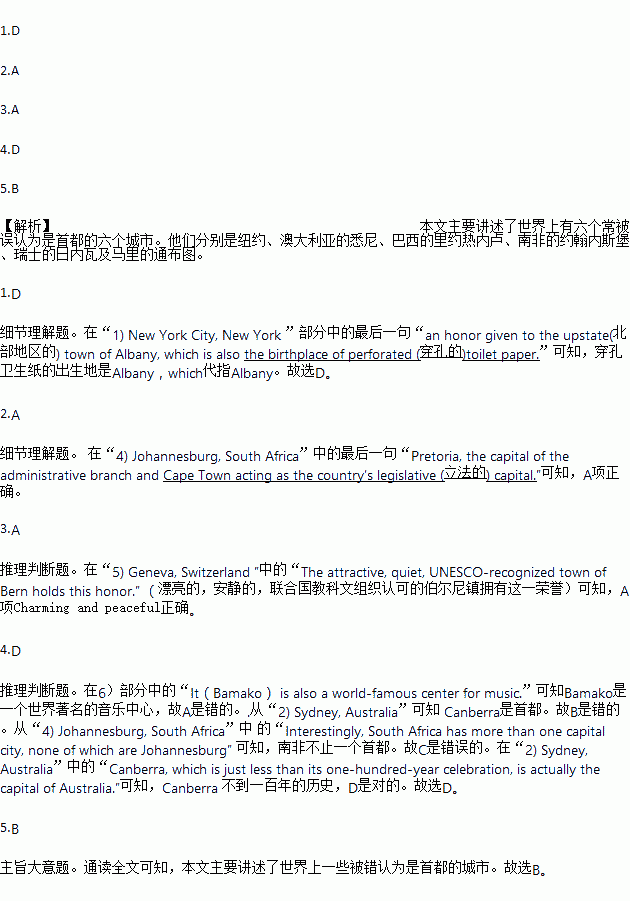题目内容
What’s the capital of Australia? If you answer Sydney, you’re wrong, with travel website VirtualTourist.com (www.virtualtourist.com) coming up with a list of the six most surprising non-capital cities in the world.
1) New York City, New York
It may be king of the hill and the top of the heap (堆), but only figuratively (比喻地). NYC is not the country’s capital, which is Washington DC. Nor is it the state capital, an honor given to the upstate(北部地区的) town of Albany, which is also the birthplace of perforated (穿孔的)toilet paper.
2) Sydney, Australia
Although it is famous for its harbor and opera house, Sydney is not the capital. Canberra, which is just less than its one-hundred-year celebration, is actually the capital of Australia.
3) Rio de Janeiro, Brazil
It’s fun, exciting and has something for everyone, but that still doesn’t make it Brazil’s capital. While the city which is famous for the festival used to be the capital, Brasilia now takes that position.
4) Johannesburg, South Africa
Interestingly, South Africa has more than one capital city, none of which are Johannesburg. Divided by branch of government the capitals are: Bloemfontein, the capital of the judiciary (司法的), Pretoria, the capital of the administrative branch and Cape Town acting as the country’s legislative (立法的) capital.
5) Geneva, Switzerland
Neither this nor Zurich serves as the country’s capital. The attractive, quiet, UNESCO-recognized town of Bern holds this honor.
6) Timbuktu, Mali
Mysterious, exotic (异国情调的), and perhaps the country’s most recognizable name, it takes second place to the city of Bamako. Bamako considered the fastest growing city in Africa. It is also a world-famous center for music. Bamako is attracting famous singers to its local pubs where hometown artists play through the night.
1.Perforated toilet paper comes from _______.
A. Geneva
B. Johannesburg
C. New York City
D. Albany
2.We can learn from the text that _______.
A. Cape Town is South Africa’s legislative capital
B. Canberra is also called the land "Down Under"
C. Pretoria is South Africa’s judiciary capital
D. Bamako is the fastest growing city in the world
3.Which of the following can best describe Bern?
A. Charming and peaceful.
B. Fun and exciting.
C. Mysterious.
D. Exotic.
4.What can we infer from the text?
A. Bamako is famous for its industry.
B. Canberra is well-known for its opera.
C. Each country has only one capital.
D. Canberra has a history of less than 100 years.
5.This text is mainly about _________.
A. some famous big cities in the world
B. some famous mistaken capital cities in the world
C. features of some capitals in the world
D. traveling in some big cities in the world

